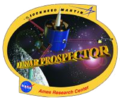Lunar Prospector
| Lunar Prospector | ||||||||||
|---|---|---|---|---|---|---|---|---|---|---|
 Graphic from the Lunar Prospector in lunar orbit |
||||||||||
| NSSDC ID | 1998-001A | |||||||||
| Mission goal | Earth moon | |||||||||
| Client |
|
|||||||||
| Launcher | Athena II | |||||||||
| construction | ||||||||||
| Takeoff mass | 295 kg (including fuel) | |||||||||
| Course of the mission | ||||||||||
| Start date | January 6, 1998, 02:28:44 UTC | |||||||||
| launch pad | CCAFS , LC-46 | |||||||||
| End date | July 31, 1999 | |||||||||
|
||||||||||
Lunar Prospector (about: " Lunar explorer") was an American space probe that explored the moon from 1998 to 1999 .
mission
According to the results of the Clementine mission , the aim of Lunar Prospector was clear: Detection of water ice at the poles of the moon .
Lunar Prospector weighed around 300 kilograms and was launched with an Athena II rocket . The mission cost only 62.8 million US dollars ; of which $ 34 million went to the probe and $ 25 million to the launcher. The orbiter was equipped with six scientific experiments. As a special "cargo" he carried a lipstick-sized capsule with a few grams of the ashes of the 1997 astronomer Eugene Shoemaker . After the end of the mission, the probe was scheduled to hit the moon, which would destroy it. If possible, water ice should be released.
course
- Lunar Prospector launched on January 6, 1998.
- The probe entered a polar orbit around the moon on January 11, 1998 .
- The mission ended when the probe hit the moon on July 31, 1999.
Results
Lunar Prospector was able to reliably detect water ice on the moon using neutron spectroscopy . These are around four billion tons on the North Pole and around two billion tons on the South Pole. The ice is not exposed, but is mixed with the rock. However, when the Lunar Prospector impacted, no ice was released. The impact occurred in a crater, as yet unnamed at the time, near the lunar south pole. Shoemaker's name was proposed for this target crater, the official name was given in 2000, see Shoemaker (moon crater) .
The probe also provided data for the production of a global lunar map of the lunar gravity field , which allows future missions to be planned more safely and in a more fuel-efficient manner ( see also: Mascon ).
The probe also provided a map of the distribution of thorium on the moon using a gamma-ray spectrometer . This radioactive element is a potential nuclear fuel that could be important for future lunar missions.
Picture gallery
See also
Web links
- NASA: Lunar prospector (English)
- AstroLink.de: Lunar Prospector
- Bernd Leitenberger: Lunar Prospector
Individual evidence
- ↑ Welcome to the Moon! ( Memento from 20090730153023)
- ↑ Sparrow, Giles., Evening, Bernhard ,: Adventure space travel: [50 years of expeditions into space] . Dorling Kindersley, Munich 2007, ISBN 978-3-8310-1089-9 .





